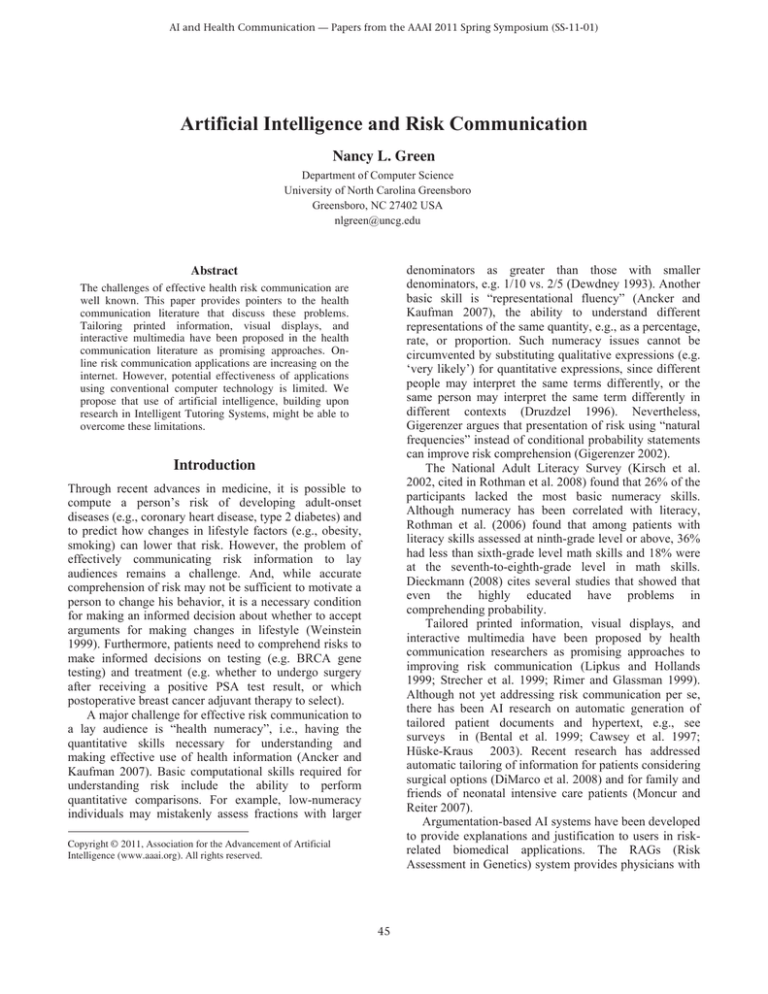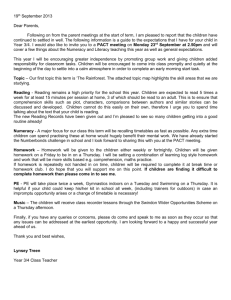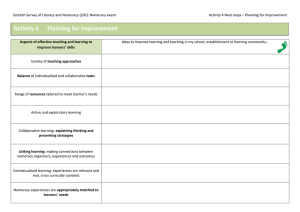
AI and Health Communication — Papers from the AAAI 2011 Spring Symposium (SS-11-01)
Artificial Intelligence and Risk Communication
Nancy L. Green
Department of Computer Science
University of North Carolina Greensboro
Greensboro, NC 27402 USA
nlgreen@uncg.edu
denominators as greater than those with smaller
denominators, e.g. 1/10 vs. 2/5 (Dewdney 1993). Another
basic skill is “representational fluency” (Ancker and
Kaufman 2007), the ability to understand different
representations of the same quantity, e.g., as a percentage,
rate, or proportion. Such numeracy issues cannot be
circumvented by substituting qualitative expressions (e.g.
‘very likely’) for quantitative expressions, since different
people may interpret the same terms differently, or the
same person may interpret the same term differently in
different contexts (Druzdzel 1996). Nevertheless,
Gigerenzer argues that presentation of risk using “natural
frequencies” instead of conditional probability statements
can improve risk comprehension (Gigerenzer 2002).
The National Adult Literacy Survey (Kirsch et al.
2002, cited in Rothman et al. 2008) found that 26% of the
participants lacked the most basic numeracy skills.
Although numeracy has been correlated with literacy,
Rothman et al. (2006) found that among patients with
literacy skills assessed at ninth-grade level or above, 36%
had less than sixth-grade level math skills and 18% were
at the seventh-to-eighth-grade level in math skills.
Dieckmann (2008) cites several studies that showed that
even the highly educated have problems in
comprehending probability.
Tailored printed information, visual displays, and
interactive multimedia have been proposed by health
communication researchers as promising approaches to
improving risk communication (Lipkus and Hollands
1999; Strecher et al. 1999; Rimer and Glassman 1999).
Although not yet addressing risk communication per se,
there has been AI research on automatic generation of
tailored patient documents and hypertext, e.g., see
surveys in (Bental et al. 1999; Cawsey et al. 1997;
Hüske-Kraus 2003). Recent research has addressed
automatic tailoring of information for patients considering
surgical options (DiMarco et al. 2008) and for family and
friends of neonatal intensive care patients (Moncur and
Reiter 2007).
Argumentation-based AI systems have been developed
to provide explanations and justification to users in riskrelated biomedical applications. The RAGs (Risk
Assessment in Genetics) system provides physicians with
Abstract
The challenges of effective health risk communication are
well known. This paper provides pointers to the health
communication literature that discuss these problems.
Tailoring printed information, visual displays, and
interactive multimedia have been proposed in the health
communication literature as promising approaches. Online risk communication applications are increasing on the
internet. However, potential effectiveness of applications
using conventional computer technology is limited. We
propose that use of artificial intelligence, building upon
research in Intelligent Tutoring Systems, might be able to
overcome these limitations.
Introduction
Through recent advances in medicine, it is possible to
compute a person’s risk of developing adult-onset
diseases (e.g., coronary heart disease, type 2 diabetes) and
to predict how changes in lifestyle factors (e.g., obesity,
smoking) can lower that risk. However, the problem of
effectively communicating risk information to lay
audiences remains a challenge. And, while accurate
comprehension of risk may not be sufficient to motivate a
person to change his behavior, it is a necessary condition
for making an informed decision about whether to accept
arguments for making changes in lifestyle (Weinstein
1999). Furthermore, patients need to comprehend risks to
make informed decisions on testing (e.g. BRCA gene
testing) and treatment (e.g. whether to undergo surgery
after receiving a positive PSA test result, or which
postoperative breast cancer adjuvant therapy to select).
A major challenge for effective risk communication to
a lay audience is “health numeracy”, i.e., having the
quantitative skills necessary for understanding and
making effective use of health information (Ancker and
Kaufman 2007). Basic computational skills required for
understanding risk include the ability to perform
quantitative comparisons. For example, low-numeracy
individuals may mistakenly assess fractions with larger
Copyright © 2011, Association for the Advancement of Artificial
Intelligence (www.aaai.org). All rights reserved.
45
a list of reasons for and against its assessment of the
qualitative risk that the patient has a genetic
predisposition to cancer (Fox et al. 2007). REACT
supports a physician in planning medical interventions
together with his patient (Fox et al. 2007). REACT
displays a dynamically updated graph of the patient’s
quantitative risk over time for the proposed plan of
action; in addition, it displays a list of reasons for and
against the proposed intervention. An argumentationbased document generation system, the GenIE Assistant
generates first-draft letters for patients of genetic
counselors (Green et al. 2011). However, none of these
systems were designed for communication with lownumeracy audiences.
Ancker et al. (2006) reviewed research on effective
design of graphs for health risk communication.
However, they note that patients may need instruction to
interpret less familiar types of graphics and that
instruction may improve comprehension of familiar types
of graphics. Lipkus (2007) summarizes current best
practices on numeric, verbal, and visual formats for health
risk communication. He notes that more research is
needed to explore the role of numeracy in making use of
numeric risk information, the reasons for certain
numerical risk formats’ superiority compared to other
formats, and how graphical displays affect risk
perception. The health communication field has begun to
deploy interactive computer applications with graphics
for
conveying
risk,
e.g.,
<http://www.nhlbisupport.com/bmi/bmicalc.htm>,
<http://www.healthcalculators.org/index.html>,
<http://hp2010.nhlbihin.net/atpiii/calculator.asp?usertype
=pub>, <http://www.yourdiseaserisk.wustl.edu/>, and
<http://www.cbssm.org/doms/how-much-willchemotherapy-really-help-you>. However, the potential
effectiveness of risk graphics in systems using
conventional computer technology is limited. Our
proposal for use of AI to overcome the limitation of
current technology is presented in the next section.
application designers. In addition, interactivity may
support navigation by the user through the presentation.
The designers may even try to anticipate the user’s
questions and provide navigation to supplementary
information to address those questions. If the user still
does not comprehend his risk, there is nothing more that
the application can provide. Furthermore, the user may
not realize that he has misunderstood the information.
We suggest that this limitation could be addressed by
research building upon techniques developed in the field
of AI and education, i.e., the intelligent tutoring systems
(ITS) field. Typically an ITS includes a domain model,
student model and a pedagogical model (Woolf 2010).
The domain model consists of subject matter to be
learned. The student model represents the student’s
current state of knowledge, skills, and/or affect. A student
model is updated by the system as it makes inferences
about the student’s current state based upon her actions in
the ITS. The pedagogical model reasons about teaching
strategies to control the presentation of topics or
provision of feedback. In addition, some ITS use
synthetic humans to guide the student in use of the
system, provide empathy, and maintain engagement.
Because of the known difficulties that many people
face in understanding risk information, it would be
beneficial for a risk communication application to
maintain a dynamically-updated fine-grained user model,
analogous to the student model of an ITS, of the
healthcare client’s risk comprehension. While presenting
tailored information about the client’s risk, the system
would interact with the client to assess his comprehension
of each part of the presentation. Based upon his actions or
answers, the system would reason about which graph
comprehension and numeracy skills that the client had not
yet acquired that could hinder his comprehension of risk
information. A risk presentation component, analogous to
the pedagogical model of an ITS, would use the model to
design or select, on the fly, graphics and explanations that
are appropriate to the current state of the user model.
In an ITS, the student model may include a model of
student affect (e.g., is the student currently frustrated,
bored, or engaged?). Inferred student affect can be used
by the pedagogical model. Furthermore in some ITS, a
synthetic human (pedagogical agent) may address the
student’s negative affective state directly by
communicating empathy. Given the role of affect in risk
perception, it may be helpful to select presentation
strategies based upon a model of user’s affective state.
For example, if the user is inferred to be worried about
his risk, the system could employ presentation strategies
that are not believed to exacerbate worry. An approach to
probabilistic reasoning about the user’s affective state for
genetic counseling systems is proposed in (Green 2005).
This is not the first proposal for an educational
intervention to improve risk communication. Schwartz et
al. (1999) propose a written tutorial to help people
Potential Contribution of AI
Following current best practice guidelines, the designer of
a risk communication computer application determines
the requirements of the target audience, the goal of the
presentation, and the appropriate design for this audience
and purpose. Ideally, the project involves interaction
design professionals who design a prototype, which
undergoes formative evaluation and is iteratively refined
(Wright et al. 2002). However, at the end of this process
the design of the graphics (and accompanying text) is
more or less fixed. Interactivity may support a limited
amount of tailoring. For example, the user may be given a
questionnaire to elicit his risk factors. The system then
uses the responses to calculate the user’s level of risk and
display it in the graphical format created by the
46
understand basic probability concepts and evaluate risk
information. The five subjects it would cover are
x How risk is described, e.g., ways to quantify risk,
and common sources of confusion
x Questions to ask about risk statements such as
what is the time frame (e.g. five years or
lifetime), what is the risk of (e.g. a disease or
death), who is at risk (e.g. all women or women
with a certain family history).
x Putting risk into context, e.g., how does the risk
compare to the risk of familiar events.
x Changing risk, e.g., in presentations on the
risk/benefit of different treatment options,
understanding the distinction between absolute
and relative risk, and framing effects.
x Evidence, e.g., evaluating the strength of evidence
such as whether it comes from a randomized
clinical
trial
or
observational
study,
understanding the confidence interval, etc.
Taking a more ITS-like approach to risk
communication, the above topics could be covered in a
user-tailored presentation with the goal of helping him
understand and make use of information about his
particular case. Note that instead of sequencing the
information in the order given in the above list, the
information could be presented at any point in the
presentation where it is needed, and tailored to the model
of the user’s current level of understanding.
Schwartz et al. discuss several potential problems with
use of a tutorial that might apply to our proposal as well.
First, a patient may say that he is not interested in using
the tutorial. However, Schwartz et al. argue, in some
cases a professed lack of interest may really indicate a
fear of not being able to understand the information, and
that the tutorial could make the quantitative information
accessible to that audience. The same defense applies to
our ITS-like proposal as well. Second, they note that a
patient facing a serious diagnosis or decision may feel too
distressed to use a tutorial. We agree. However, as noted
above, synthetic humans have been used in ITS to
mitigate negative student affect. Employing models from
the counseling literature, synthetic humans have been
used to help clients learn skills to cope with stress
(Marsella et al. 2000). Thus, given empirical research on
how to communicate risk in such situations, an AI-based
system could include a synthetic human to embody that
approach. Furthermore, for patients who prefer to have a
thorough understanding of their condition and options,
knowledge gained through use of our proposed system
may provide some emotional relief.
Journal of the American Medical Informatics Association
14(6):713-721.
References
Hüske-Kraus D. 2003. Text Generation in Clinical
Medicine – A Review. Methods Inf Med 42:51-60.
Ancker, J.S. and Kaufman, D. 2007. Rethinking Health
Numeracy: A Multidisciplinary Literature Review.
Lipkus, I.M. 2007. Numeric, Verbal, and Visual Formats
of Conveying Health Risks: Suggested Best Practices and
Ancker, J.S., Senathirajah, Y., Kukafka, R., and Starren,
J. 2006. Design Features of Graphs in Health Risk
Communication: A Systematic Review. Journal of the
American Medical Informatics Association 13:608-618.
Bental, D.S., Cawsey, A., and Jones, R. 1999. Patient
Information Systems that Tailor to the Individual. Journal
of Patient Education and Counseling 36: 171-180.
Cawsey, A., Webber, B.L., and Jones, R.B. 1997. Natural
Language Generation in HealthCare. Journal of the
American Medical Informatics Association 4(6): 473-483.
Dewdney, A.K. 1993. 200% of Nothing. New York: John
Wiley and Sons, Inc.
Dieckmann, N. 2008. Numeracy: A Review of the
Literature. Decision Research Report No. 08-2. Decision
Research and University of Oregon.
DiMarco, C., Bray, P., Covvey, H.D., Cowan, D.D.,
DiCiccio, V., Hovy, E., Lipa, J. and Yang, C. 2008.
Authoring and generation of individualised patient
education materials. Journal on Information Technology
in Healthcare.
Druzdzel, M. J. 1996. Qualitative Verbal Explanations in
Bayesian Belief Networks. Artificial Intelligence and
Simulation of Behavior Quarterly, 94:43-54.
Fox, J., Glasspool, D., Grecu, D., Modgil, S., South, M.,
and Patkar, V. 2007. Argumentation-based inference and
decision-making – a medical perspective. IEEE Intelligent
Systems 22(6): 34-41.
Gigerenzer, G. 2002. Reckoning with Risk: Learning to
Live with Uncertainty. London: Penguin Books.
Green, N. 2005. Affective Factors in Generation of
Tailored Genomic Information. User Modeling 2005
Workshop on Adapting the Interaction Style to Affective
Factors, Edinburgh.
Green, N., Dwight,R., Navoraphan, K., and Stadler, B.
2011. Natural language generation of transparent
arguments for lay audiences. Argument and Computation,
to appear.
47
Future Recommendations. Medical Decision Making 27:
696-713.
Lipkus, I.M. and Hollands, J.G. 1999. The Visual
Communication of Risk. Monographs of the Journal of
the National Cancer Institute 25: 149-162.
Marsella, S.C., Johnson, W.L., and LaBore, C. 2000.
Interactive Pedagogical Drama. In Proceedings of the 4th
International Conference on Autonomous Agents, 301308.
Moncur, W. and Reiter, E. 2007. How Much to Tell?
Disseminating Affective Information across a Social
Network In Proceedings of the Second International
Workshop on Personalisation for e-Health.
Rimer, B.K. and Glassman, B. 1999. Is There a Use for
Tailored Print Communications in Cancer Risk
Communication? Monographs of the Journal of the
National Cancer Institute 25: 140-148.
Rothman, R.L., Montori, V.M., Cherrington, A., and
Pignone, M.P. 2008. Perspective: The Role of Numeracy
in Health Care. Journal of Health Communication,
13:583-595.
Schwartz, L.M., Woloshin, S., and Welch, H.G. 1999.
Risk Communication in Clinical Practice: Putting Cancer
in Context. Monographs of the Journal of the National
Cancer Institute 25: 124-133..
Strecher, V.J., Greenwood, T., Wang, C., and Dumont, D.
1999. Interactive Multimedia and Risk Communication.
Monographs of the Journal of the National Cancer
Institute 25: 134-139.
Weinstein, N. D. 1999. What Does It Mean to Understand
a Risk? Evaluating Risk Comprehension. Monographs of
the Journal of the National Cancer Institute 25: 15-20.
Woolf, B. 2009. Building Intelligent Interactive Tutors.
Burlington, MA.: Morgan Kaufmann.
Wright, P., John, C., and Belt. S. 2002. Designing an
interactive decision explorer. Information Design Journal
11(2/3): 252-260.
48




